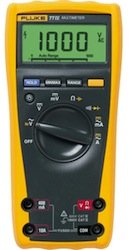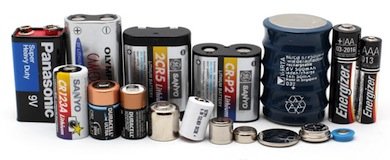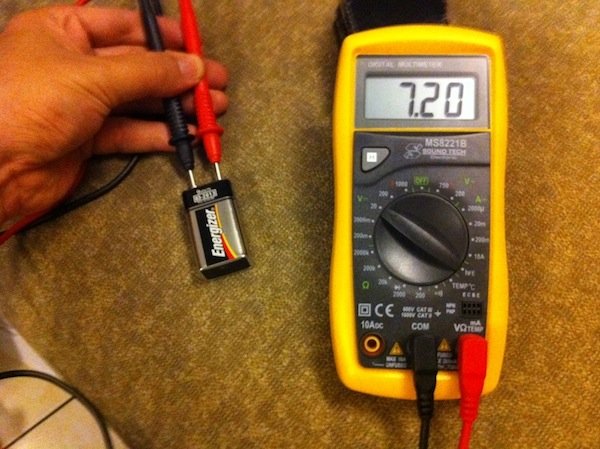Sometimes these batteries are kept for use in low voltage applications such as clocks and remote controls, but there is a lower limit voltage where the battery will no longer be useful.

If you’re like me, you would have a voltmeter or multimeter in your possession just for fun. And if you’re like me, there would be lots of used batteries lying around the house.
Here’s where we put the multimeter and used batteries together for a better purpose. Checking battery voltage level with a multimeter helps you to determine if that old battery lying around in the drawer is still fit to power your devices.

Different kinds of batteries have different levels and ranges of usable voltage.
To make things even more complicated, different devices have different voltage demands to run them properly. Batteries considered dead in a high-power demand device such as a radio-control car will often still work in a low-power demand device such as an analogue wall clock, and for a reasonable length of time.
Another thing to note is in a dead flashlight, not all the batteries are dead, and you will usually find that only one in a series of four is completely discharged, and the other three would still have sufficient voltage.
The reason device and battery manufacturers recommend that old batteries should not be mixed with new ones is to prevent leakages. This is because the average consumer does not have a battery tester or multimeter to test the remaining voltages of used batteries, to know which could be kept or which to be discarded.
All the variations above notwithstanding, the following is a range of what I consider to be the voltage usable levels of Alkaline and rechargeable Nickel-Metal Hydride (NiMH) batteries:
Non-Rechargeable Alkaline Batteries
For the non-rechargeable Alkaline batteries that start off at 1.5V:
| Alkaline Voltage Level and Range (V) | Usability |
|---|---|
| 1.50 | New and unused |
| 1.35 – 1.49 | Good |
| 1.20 – 1.34 | Average |
| 1.10 – 1.19 | Low |
| 0.90 – 1.09 | Very Low |
| < 0.90 | Dead – Discard! |
Rechargeable Nickel-Metal Hydride Batteries
For the rechargeable Nickel-Metal Hydride batteries that start off at 1.2V:
| NiMH Voltage Level and Range (V) | Usability |
|---|---|
| 1.20 | New and unused |
| 1.16 – 1.19 | Good |
| 1.12 – 1.15 | Average |
| 1.10 – 1.11 | Low |
| 0.90 – 1.09 | Very Low |
| < 0.90 | Dead – Discard! |
Checking Battery Voltage Levels
So, just how do you check the voltage level on a semi-used battery? Easy, you use a battery tester or voltmeter, or as in our case today, a digital multimeter to measure the voltage level.



 Generally, a battery is considered dead when it has fallen to about 60% of its original as-new voltage. In the case of a 1.5V, this corresponds to 0.8V, and for a 9V battery, about 5.4V.
Generally, a battery is considered dead when it has fallen to about 60% of its original as-new voltage. In the case of a 1.5V, this corresponds to 0.8V, and for a 9V battery, about 5.4V.
Surprisingly to most people, batteries will begin to show signs of weakness once it reaches 80% of its original voltage – 1.2V for a 1.5V battery, and 7.2V for a 9V battery.
Based on these figures, you could also test your car’s 12V battery.
At 10V and above, you could probably still jumpstart the car and recharge the battery if it is found to be weak and your car won’t start. Anything below 9.6V (80%) on this accumulator is considered too weak for further use, and at 7.2V (60%) should be disposed off for recycling.
And speaking of recycling, you are advised to dispose off your depleted batteries at proper recycling bins, as throwing them away with your household general waste can lead to, in a phrase, unfavourable environmental consequences.


baidu…
baidu http://www.baidu.com…
thanks for the great info. My 9volt battery shows 8.5 volts so it should be good for awhile longer.
Even a 9 volt battery with 5 volts left still can be used for instance if a motor needs a 3 volt supply instead of using 2 AA cells technically i could use this 5 volt or lower half dead 9volt battery
Of course it would not fit in to the battery compartment as the 2 AA batteries would
But in theory I would keep the 9 volt battery for my hobbies
My smoke alarm starting beeping this morning (thank God it was 9:30am not 2:30am) when the 9v battery tested 7.7v